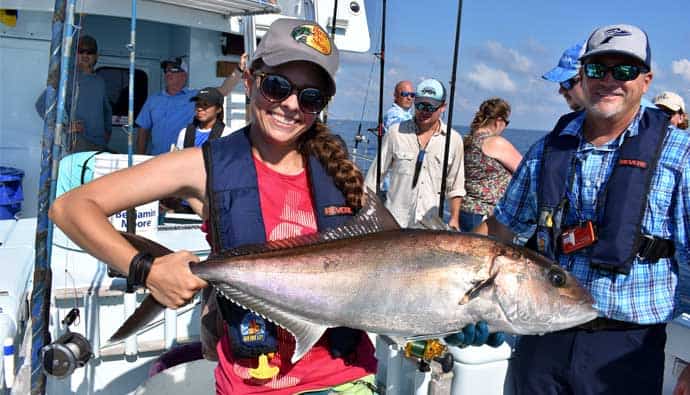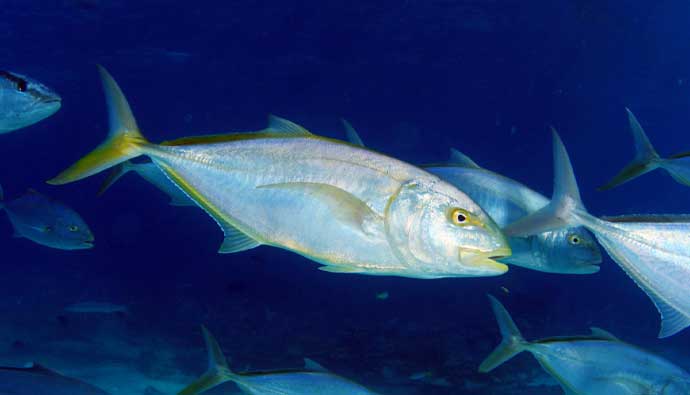Are you in search of a game fish you can test your fishing skills on?
If you answered yes, try catching the popular game fish, amberjack.

There are two species of amberjacks you will encounter – greater and lesser with the former being the most popular. Both are fun to catch, just be careful not to search YouTube for those amberjack worms videos…they can be chilling :).
Let’s dive into how to catch giant amberjack!
Overview
Also known as jacks, amber fish, jackhammer, and horse-eye jack, this fish is sought after by anglers because of the quality of its meat. Considered to be a vicious fighter, the greater amberjack is greenish blue to almost purplish below the lateral line.
It has small teeth and a broad amber stripe that runs along the sides. The lesser amberjack is olive green in color and is silver below. The only features that distinguish it from the greater species are its body which has a deeper profile and larger eyes.
Amberjacks are a wide-ranging fish and can be found in reefs, rocky outcrops, wrecks, and other underwater structures. Bigger amberjacks usually band together in small groups and the fish is not an endangered species.
Amberjack Facts
| Scientific Name | Serola dumerili (greater amberjack) / Serola fasciata (lesser amberjack) |
| Common Name(s) | Amberjack (greater and lesser), amber jack, jackhammer, horse-eye jack, yellowtail jack |
| Family | Carangidae |
| Characteristics | Bluish grey to olive back with an olive stripe that goes from the eye to the middle of the body. Teeth form broad bands in both jaws. |
| Depth Range | 60 to 400 feet |
| Locations | It can be found in the Indo Pacific area around China, Japan, and the Philippines or in tropical and temperate waters. |
| Limits | Check your local regulations |
AmberJack Habitat
You can find greater amberjack offshore at considerable depths and in offshore reefs, wrecks, oil rigs, etc.
Catch them anywhere in the water column but you can spot them around structures that are near the bottom of the sea bed around the 60 to 240 feet range.
If you are looking for lesser amberjack, you will have to go deeper (from 180 to 400 feet deep) to find it. These are only found offshore so you will need to take a boat far out into the waters and dive for them. If you’re in the states, be sure to go after Florida amberjack or amberjack fish in Hawaii.
How to Catch Amberjack
If you want to fish for amberjack, you better target the greater species. It puts up a heck of a fight but the struggle is worth the huge catch. Landing one is more about getting it onto the deck after it is hooked than getting it to bite. That’s because, unlike other game fish, it does not tire and will keep fighting right up till the boat.

Since amberjack is quite a heavy fish, you can use the conventional tackle but you can also use a heavy spinning tackle if it is sturdy enough. Use a reel that can withstand 100 pounds and a strong-backed spinning rod.
When it comes to amberjack bait, this fish is far from picky, so you can use whatever type you can get your hands on. Live bait is more attractive to amberjacks such as mullet, cigar minnows, pinfish, and threadfin herring.
If you prefer amberjack lures, use a vertical jig which will sink straight down to the bottom where the fish is swimming around.

Amberjack Fishing Tactics
- If you are trolling for amberjacks on the surface, use feathers, strip baits, plugs, and spoons to attract the fish. Amberjack jig fishing is also a popular way to catch these fish if you’re not interested in trolling.
- Don’t fish for this species with any old line. Amberjacks are quite strong and will break a line that is not braided or which isn’t monofilament. A braided fishing line cuts through ocean currents and can withstand the long fight this fish puts up without snapping.
- To attract amberjacks that are in shallow water use plugs. These are buoyant enough to entice them to bite.
Amberjack Fishing Tips
- Jacks are strong enough to put up a long fight and have even been known to drag anglers underwater. Wear a lifejacket as a precautionary measure in case you fall in as well.
- You can find jacks in plenty near old wrecks and around natural/artificial coral reefs.
- Set the drag preset to match your strength and the equipment you are using, or you will get injured while fishing.
Amberjack Seasons
Greater amberjack swims in groups as it grows but becomes solitary traveler as it grows older. You can find them in the open sea or ocean almost all year long, from April to early winter.
If you want to increase your chances of bagging one, fish for it during autumn during sunrise and sunset. Amberjack fishing also improves throughout the winter off the coasts of Florida as the fish migrates to spawn.
During this time, you can find jacks around structures up to 60 to 240 feet deep underwater.
Spearfishing Amberjack
If you’re lucky enough to be in the area with amberjacks, then you should test your skill by going for one of these giants with your speargun. Since they are powerful, you’re going to want a slip tip and a larger gun with a float.

How to Clean Amberjack
- Lay the amberjack on the cutting board and take the back and side fin off before removing the scales. You can also use kitchen scissors for this.
- Shave off the skin by laying the knife on its side on the fish and slicing.
- Lay the fish belly up and place the tip of the knife in from the bottom of the fin.
- Run the knife along the side of the fin towards the head.
- Make a cut from the stomach to the head the same way and open up the belly. Then make a cut from the anal vent right up to the head/
- Pull out the intestines from the open cavity and cut the backbone and head off. The guts should come off with the head as well.
- Cut right through the fish from the tail toward the head right to the center on both sides of the fish.
- Make a cut along the back by running the knife from the main bone and with the front side facing up.
- Cut along the belly the same way keeping the knife at the same angle, and remove the fillet.
How to Cook Amberjack
Cooking amberjack is one of the preferred ways to eat amberjack fish. If your fish doesn’t have worms, then you can also opt for some amberjack sushi or sashimi…just always be careful when consuming raw fish.
Amberjack tastes amazing and is a prized fish to consume.
Amberjack Recipe
- Add salt and pepper to the fish fillets.
- Heat a large nonstick pan to medium-high and add enough butter to coat it.
- When the butter melts, place the fillets in the pan skin side first.
- Squeeze some lemon over each piece and add a couple of thyme sprigs over them.
- Cook for 3 minutes uncovered, and then flip when the flesh turns brown and buttery.
- Cook the other side the same way or till the flesh is flaky.
- Serve with veggies.
FAQs
Amberjack is coveted because of its succulent meat. It has a mild taste and requires little seasoning.
Although it is listed as yellowfin tuna on some restaurant menus amberjack is a completely different species of fish.
Yellowtail is also called Japanese amberjack, but they are not the same fish.
Insider Advice
Amberjacks are fierce fighters, but their succulent meat is well worth the struggle you will have to put up with it to reel one in. If you have fishing tips and strategies that can make this easier, do share them in the comments and share this guide.




 Facebook
Facebook YouTube
YouTube









